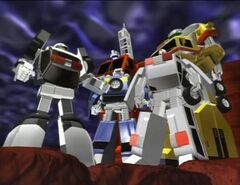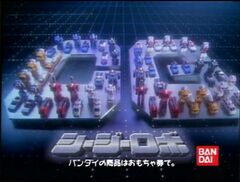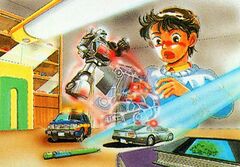CG Robo (franchise)
|
|
| ||||||||
|---|---|---|---|---|---|---|---|---|
CG Robo (シージーロボ ShīJī Robo), also known as Machine Robo: CG Robo, was a Machine Robo franchise from Japan that ran during 1993. The 'CG' stood for 'Change and Glow', referring to the toys' ability to not only being able to change modes but also being equipped with working electronic lights. It was the first new instalment of Machine Robo since 1988 and would be the last until 2001.
The revival was possibly influenced by the existence of Transformers: Generation 2, which was shortly to be imported by Takara.
Overview[edit | edit source]
Toyline[edit | edit source]
- Main article: CG Robo (toyline)
PLEX designed all-new figures for the range. While they had designed all of the Machine Robo figures since their predecessor Popy had been reabsorbed into Bandai in 1983 this was the first time they were credited on the toys themselves. Each was around an inch taller than the Machine Robo Series figures, and retailed at ¥1500. The figures all transformed into contemporary vehicles, though fishing in familiar ground to both previous incarnations of Machine Robo and any other transforming robot line - emergency vehicles and construction vehicles featured strongly. All had electronic working lights accessible in both modes; these were powered by two LR-41 batteries, which infuriatingly cannot be replaced without - in some cases - destroying the toy. While some featured diecast parts the vast majority of each toy was made from ABS plastic, and they often relied heavily on stickers for detailing.
14 figures were released; two more - Steam CG and Drill CG - were advertised but do not seem to have progressed beyond the concept stage.
Fiction[edit | edit source]
There was no cartoon to promote CG Robo; in a throwback to the original Machine Robo line what backstory for the line existed was disseminated via toy packaging and commercials. As usual for the Machine Robo meta franchise it had no overt ties to the previous incarnations. While the two sources don't give mutually-exclusive information neither do they mesh together seamlessly.
Pack-in material[edit | edit source]
According to material in the catalogues included with the toys, a boy named Koji was playing with his collection of toy cars when a beam of light came through his window and struck them. They developed flashing lights and transformed into robots. After seeing a skyscraper fire on the news the CG Robo grew to giant size and went to deal with the disaster. The CG Robo were constructed of self-healing CG Metal, while the mysterious cosmic energy that powers them is a clean fuel than produces enormous energy but no toxic side-effects.
Commercials[edit | edit source]
The line was promoted by two commercials using CGI animation produced by Polygon Pictures, with multiple edits of both made. Both commercials - including several alternative takes - were included on the Machine Robo Visual Records DVD included with Machine Robo Wedge.
Overseas[edit | edit source]
While Tonka had been absorbed by Hasbro in 1991, Bandai had grown to become a force in their own right in the American market. However they did not release the line in North America. They did however release the first five figures in the European Robo Machines line as "Light & Sound Robo Machines" with minor stickering changes, alongside various reissues of "classic" 1980s moulds. As the rights to the GoBots trademarks had gone to Hasbro in the Tonka takeover these were given new names.



